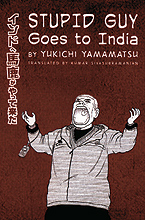No, the title isn’t ironic at all. A fifty-six-year-old out-of-work manga artist in Japan has an epiphany: There are no mangas in India, an inexcusable lacuna. If I were to land up in India — where I don’t know a soul — with a bunch of comics (not necessarily mine), have them translated into Hindi and sell them, I’d be rendering a great service to the human race (or at least to a sixth of it). And, of course, I’ll make a small fortune along the way.
What follows is a series of formulaic misadventures and disappointments that every foreign tourist who comes to India (or shall we just say Delhi, because the book doesn’t really go beyond) is familiar with: pickpocketing and the unhelpful policemen one encounters after, filthy public toilets (acutely distressing to Yamamatsu and I’ll explain why in just a second), food that’s too spicy, autowalas who take you for a ride, touts and sly shopkeepers galore. Of course, Yamamatsu is a bit of a long-stay atithi so there are worse horrors in store, devious real estate agents for one.
When you’ve sifted through this morass, there is a story. Of how India’s first Hindi manga came to be (in 2005). It’s a tale as heroic as it is tragic. The fruit of Yamamatsu’s entrepreneurial labours was the publication of Hiroshi Hirata’s gory samurai tale Chidaruma Kempo. Hardly any copies were sold. (Full disclosure: I bought a copy.)
Yamamatsu’s rather dogged quest will perhaps strike a chord, dryly literal though the narrative is. The manga artist had his sigmoid colon removed during a cancer operation and this has given him rather unique and precarious bowel movements, and you can enjoy a graphic description on p. 68. Or turn to chapter 24 for an experience of visiting a brothel on G.B. Road, narrated in the same persecuted vein. I’d say it should be compulsory reading for the proudly Indian — it’s educational, seeing ourselves as others see us.
Well, what do you know — stupid people never learn.




